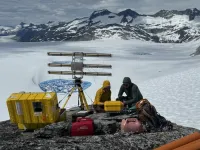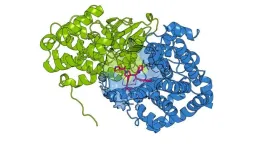(Press-News.org) The Department of Defense (DOD) has awarded a $9 million contract to the University of Maine for research that will significantly expand efforts to quantify snowpack properties, explore the impact of snowmelt on the surrounding terrestrial environments of Alaska and Maine, and expand training opportunities in polar science.
The project is led by School of Earth and Climate Sciences and Climate Change Institute faculty member Seth Campbell, who will collaborate with more than a dozen other scientists from UMaine and other institutions. The effort builds on a related and existing DOD-funded research project at UMaine spearheaded by professor of earth and climate sciences Chris Gerbi and Campbell. Partner institutions include the University of Alaska Fairbanks, the University of Alaska Southeast, the University of Colorado Boulder, the University of Portland and the Juneau Icefield Research Program.
“The focus of this project is to improve our understanding of water storage and movement in snow through the near surface geology and its impacts on stability of that geology,” said Campbell. “We know that snow holds meltwater and that, through the spring, snow melts and the meltwater can run off or be stored in the near surface geology beneath the snow. What we’re trying to differentiate here is how much water is getting stored, how much is running off and what impact the water has on the underlying terrain.”
Such work is critical, said Campbell, because of differences in the characteristics of wet and dry snowpacks and gaps in understanding of how wet snowpacks inhibit accurate measurement of meltwater.
“As global temperatures warm, we’re expecting to see wet snowpacks more often,” Campbell said. “Understanding wet snow and snow meltwater movement is an important component of research moving forward because it’s likely to have a big impact on water resources. Snow has a porosity, and that pore space can either be filled with water or not filled with water. We can currently be off by roughly 50% of our total estimate of water volume in snowpack using current field or remote sensing methods, depending on the measurement technique. With that uncertainty comes uncertainty about the resulting meltwater — how much of it runs off, how much is stored in the ground and for how long. Little is known about the impacts of that meltwater on ground stability, or how land stability may change with increasing meltwater impacts."
The project also functions as a polar proving ground and training program that builds on the foundation of the long-running Juneau Icefield Research Program (JIRP), which already brings graduate and undergraduate students, as well as high school juniors and seniors, to the icefield for an eight-week immersive educational and expeditionary experience.
Project study areas include multiple sites in Southeast and Central Alaska, including the Juneau Icefield.
“The Juneau Icefield Research program was established in 1946 and, with the exception of 2020, researchers and students have been there every summer,” said Campbell. “This funding also supports JIRP and allows us to integrate the student participants more fully into the research projects we’re doing. They’ll be able to help us a lot more with the actual science, and, with their help, we’ll be able to get more detailed observations over a longer period of time than you traditionally would with a smaller team.”
The integration of legitimate research into JIRP education initiatives has helped it to become one of the most sought-after polar Earth systems science field training programs in the U.S. JIRP has grown significantly in recent years, and is now co-led by Campbell at UMaine as Director of Research, Brad Markle at University of Colorado Boulder as the Director of Academics, and Annie Boucher as Director of Operations. Since 2018, more than $16 million in federally funded awards to faculty at UMaine and other scientists across the U.S. have partially supported JIRP-affiliated high school, undergraduate and graduate student and teacher education programs.
In the primary JIRP summer program, students learn to safely live and work on the glaciers, how to conduct field research in polar Earth systems science, and they design and carry out their own research projects under faculty mentorship. The JIRP student program works in parallel with a variety of research teams who use JIRP facilities for their field campaigns. Throughout the summer, JIRP students, with support from educational staff, are implanted with research teams to further their mentorship and training goals.
“One of our goals is to make the icefield more open and inclusive and to turn it into a collaborative research and training program where those of us in the polar science community across the country can work on separate projects or collaborate while also providing student training,” said Campbell. “Because so much of the Juneau Icefield is on U.S. soil, we have an advantage of accessibility and affordability and more than 75 years of institutional knowledge about operating in this environment and the changes that have occurred there over time. We can’t do everything that we could do in Antarctica or Greenland, but there's a lot we can study in Alaska on the icefield.”
This project will also involve research conducted at several locations across Maine and New Hampshire, and the contract supporting it will cover the purchase of highly specialized equipment for a range of uses. A new airborne LiDAR system will be used on UMaine’s Cessna airplane to map surface elevation and vegetation properties at study sites in New England. The university will also acquire two terrestrial radar interferometry systems that can be used to capture very small changes in land deformation or erosion over short time periods. In addition to its use for this contract, the interferometry and LiDAR equipment will be valuable for other research of importance to the state of Maine over the coming years, including for forestry, agriculture, geoscience and engineering applications.
The award started on July 8 and field research will begin this winter across both Maine and Alaska.
Story by Ashley Forbes.
END
DOD awards $9M for snowpack and meltwater research and Arctic training program in Alaska and New England
2024-10-01
ELSE PRESS RELEASES FROM THIS DATE:
SETI Institute awards education grant through the STRIDE program
2024-10-01
SETI Institute Awards Education Grant through the STRIDE Program
October 1, 2024, Mountain View, CA – The SETI Institute awarded its first education grant through its Support Technology, Research, Innovation, Development and Education (STRIDE) program. The grant supports a new project called Encountering Stars in an Inflatable Planetarium, which will offer immersive astronomy and astrobiology experiences for elementary and middle school students in low-income areas and high school and adult audiences interested in STEM-related experiences. The program also includes a training workshop for K-12 teachers ...
NYU Historian Jennifer L. Morgan wins 2024 MacArthur “Genius Grant”
2024-10-01
New York University historian Jennifer L. Morgan, whose work focuses on the institutionalization of race-based slavery in early America and the Black Atlantic, has been named a 2024 MacArthur Fellow by the John D. and Catherine T. MacArthur Foundation.
MacArthur Fellows are recipients of the foundation’s “genius grants,” who each receive $800,000 over a five-year period to pursue intellectual, social, and artistic endeavors.
“The 2024 MacArthur Fellows pursue rigorous inquiry with aspiration and purpose,” says MacArthur Fellows Director ...
Research in 4 continents links outdoor air pollution to differences in children’s brains
2024-10-01
Outdoor air pollution from power plants, fires and cars continues to degrade human, animal and environmental health around the globe. New research shows that even pollution levels that are below government air-quality standards are associated with differences in children’s brains.
A University of California, Davis, research team systematically analyzed 40 empirical studies, the majority of which had found that outdoor air pollution is associated with differences in children’s brains. These differences include volumes of white matter, which is associated with ...
UTA physicists explore possibility of life beyond Earth
2024-10-01
Are there planets beyond Earth where humans can live? The answer is maybe, according to a new study from University of Texas at Arlington physicists examining F-type star systems.
Stars fall into seven lettered categories according to their surface temperature. They also differ in other factors including mass, luminosity, and radius. F-types are in the middle of the scale, hotter and more massive than our sun. F-type stars are yellowish white in color and have surface temperatures of more than 10,000 degrees.
A habitable zone (HZ) is the distance from a star at which water could exist on orbiting planets’ surfaces. In the research led by doctoral student Shaan Patel ...
Seeing double: Designing drugs that target “twin” cancer proteins
2024-10-01
LA JOLLA, CA—Some proteins in the human body are easy to block with a drug; they have an obvious spot in their structure where a drug can fit, like a key in a lock. But other proteins are more difficult to target, with no clear drug-binding sites.
To design a drug that blocks a cancer-related protein, Scripps Research scientists took a hint from the protein’s paralog, or “twin.” Using innovative chemical biology methods, the scientists pinpointed a druggable site on the paralog, and then used that knowledge to characterize drugs that bound to a similar—but more difficult to detect—spot on its twin. Ultimately, they found drugs ...
Fierce names Insilico Medicine as one of its Fierce 50 Honorees of 2024
2024-10-01
Cambridge, MA, Sept. 26, 2024 –Insilico Medicine, a clinical-stage generative AI-driven drug discovery company, announced today that Fierce Life Sciences and Fierce Healthcare have named Insilico Medicine as one of 2024’s Fierce 50 honorees. The Fierce 50 showcases 50 individuals and companies driving advancements in medicine, fostering innovation and shaping the future of biopharma and healthcare.
“The annual Fierce 50 special report highlights individuals and companies that are driving progress in the pharmaceutical, healthcare and biotechnology industries,” said Ayla Ellison, Editor-in-Chief of Fierce Life Sciences and Healthcare. “These 50 outstanding ...
Cleveland Clinic researchers build first large-scale atlas of how immune cells react to mutations during cancer immunotherapy
2024-10-01
A Cleveland Clinic-led research collaboration between Timothy Chan, MD, PhD, Chair of Cleveland Clinic’s Global Center for Immunotherapy, and Bristol Myers Squibb has published the most comprehensive overview to date of how the immune system reshapes tumor architecture in response to immune checkpoint therapy.
The eight-year study, published in Nature Medicine, outlines how cancer immunotherapy induces tumor recognition through neoantigens to reshape the tumor ecosystem. Neoantigens are small peptides produced when cancer cells mutate and are a primary marker for the immune system to recognize cancer cells as different ...
Pioneering quantum computer research continues in Baden-Württemberg
2024-10-01
Utilizing the potential of quantum computers and achieving a real advantage for practical applications — this goal is being pursued worldwide. In Baden-Württemberg, the Competence Center Quantum Computing Baden-Württemberg (KQCBW) has dedicated itself to this goal over the past four years. Great progress has been made in various areas of quantum computing in successful joint projects. The success of the KQCBW is now to be continued and the unique quantum computing ecosystem in the state further expanded.
The KQCBW will be continued in a ten-month transfer project ...
Discovery of orbital angular momentum monopoles enables orbital electronics with chiral materials
2024-10-01
In traditional electronics, information is transferred using the charge of electrons. However, future technologies may rely on a different property of electrons—their intrinsic angular momentum. Historically, the focus has been on electron spin, a form of build-in angular momentum that creates a magnetic moment, as the leading candidate for next-generation devices. Now, researchers are exploring the potential of orbitronics, a field that utilizes the angular momentum of electrons generated as they orbit the atomic nucleus. Orbitronics holds great promise ...
New mouse models offer valuable window into COVID-19 infection
2024-10-01
LA JOLLA, CA—Scientists at La Jolla Institute for Immunology (LJI) have developed six lines of humanized mice that can serve as valuable models for studying human cases of COVID-19.
According to their new study in eBioMedicine, these mouse models are important for COVID-19 research because their cells were engineered to include two important human molecules that are involved in SARS-CoV-2 infection of human cells—and these humanized mice were generated on two different immunologic backgrounds. ...






